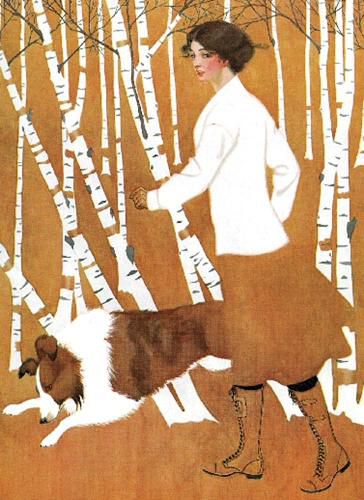Readings Newsletter
Become a Readings Member to make your shopping experience even easier.
Sign in or sign up for free!
You’re not far away from qualifying for FREE standard shipping within Australia
You’ve qualified for FREE standard shipping within Australia
The cart is loading…






This convenient little notebook, ideal for carrying in a pocket or handbag, features 64 blank pages and a stylish cover by illustrator Coles Phillips. The artist’s work frequently appeared in American periodicals of the 1910s and 20s, and this image of a young woman and collie striding through a stand of birches is a prime example of his famed fadeaway style and originally graced the cover of a 1911 issue of Life magazine. AUTHOR: Coles Phillips (1880 1927) was among the most in-demand illustrators in his field during the 1910s and 20s. A dynamic and highly skilled watercolor artist and draftsman, Coles did dozens of covers for mainstream American magazines. In 1908 he created a style in which the figure in the foreground blended seamlessly into the background, rendering some amount of the clothing invisible, save for the edges. Dubbed The Fadeaway, the eye-catching technique became a huge hit and was employed to great effect by the artist for the rest of his career.
$9.00 standard shipping within Australia
FREE standard shipping within Australia for orders over $100.00
Express & International shipping calculated at checkout
This convenient little notebook, ideal for carrying in a pocket or handbag, features 64 blank pages and a stylish cover by illustrator Coles Phillips. The artist’s work frequently appeared in American periodicals of the 1910s and 20s, and this image of a young woman and collie striding through a stand of birches is a prime example of his famed fadeaway style and originally graced the cover of a 1911 issue of Life magazine. AUTHOR: Coles Phillips (1880 1927) was among the most in-demand illustrators in his field during the 1910s and 20s. A dynamic and highly skilled watercolor artist and draftsman, Coles did dozens of covers for mainstream American magazines. In 1908 he created a style in which the figure in the foreground blended seamlessly into the background, rendering some amount of the clothing invisible, save for the edges. Dubbed The Fadeaway, the eye-catching technique became a huge hit and was employed to great effect by the artist for the rest of his career.